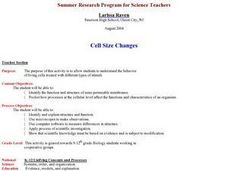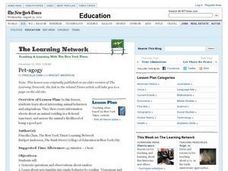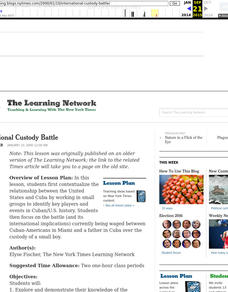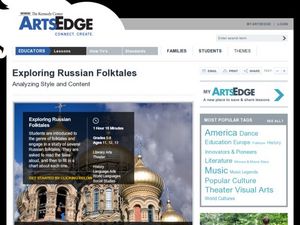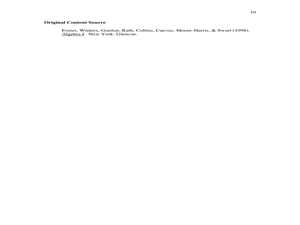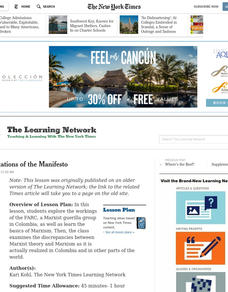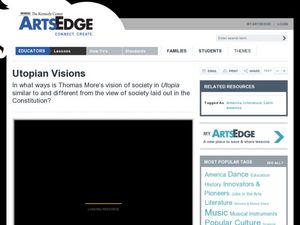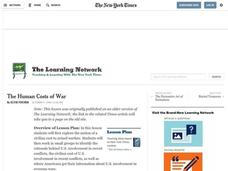Curated OER
Race, Education, and Income: Comparing Carter & Reagan
High school learners compare economic outcomes for 3 racial groups under the presidencies of Jimmy Carter and Ronald Reagan by analyzing a series of graphs, answering questions from a worksheet, and participating in a discussion.
Curated OER
Cell Size Changes
Students examine the behavior of living cells treated with different types of stimuli. They watch an online movie, examine wet mount slides under a microscope, take an online quiz, and analyze data.
Curated OER
Projectile Motion
Students observe projectile motion and calculate the speed of a baseball based on the time and distance traveled. They record the time, measure the distance, and draw the path of the ball's travel on a data table.
Curated OER
School Lighting Audit Action Plan
High schoolers write a school lighting audit action plan from the data they collected in previous lessons. They develop a presentation that shows the results of the data and their recommendations. They present their action plan to their...
Curated OER
Introduction to Tangent Lines using the TI-Nspire
Students make mathematical argument using the concept of Limit. In this algebra lesson, student calculate the instantaneous rate of change from the linear graph. They use a TI-calculator to create a visual of the graphs.
Curated OER
School Lighting Audit Preparation
Students work together to develop a school lighting audit plan. They practice using new vocabulary related to an energy audit. They also identify the components of a school lighting audit.
Curated OER
Electrifying Electricity
Students explore the basics of electricity using common everyday items as well as demonstrate how parallel and series circuits can be used in electronics and electrical devices. They explore how common items in their world can be wired...
Curated OER
Civil War Letters
Students put themselves in the shoes of American Civil War soldiers. In this Civil War lesson, students examine letters from the time period written by soldiers, edit the letters for grammatical errors, and then present the letters to...
Curated OER
Pet-agogy
Learners explore interesting animal behaviors and adaptations. They create information sheets about an animal residing in a fictional sanctuary and assess the animal's likelihood of being a good pet.
Curated OER
International Custody Battle
Students research the relationship between the United States and Cuba by identifying key players and events in Cuban/U.S. history. They also focus on a battle waged between Cuban-Americans in Miami and a father in Cuba over the custody...
Curated OER
Deep Roots of Ancient Greece
Students investigate Greek contributions to modern America. In this ancient Greek influence lesson, students watch videos, listen to lectures, and conduct research regarding ancient Greek ideals in order to analyze and trace Greek...
Curated OER
Exploring Russian Folktales
Students examine Russian Folktales. In this folklore lesson, students discuss the attributes of common folktales they know and then discover details regarding Russian folktales. Students read 3 folktales and then complete the provided...
Curated OER
Twain: Tom Sawyer—Mythic Adventurer
High schoolers take a closer look at archetypes. For this characterization lesson, students examine the setting and the characters of The Adventures of Tom Sawyer as they read and analyze the novel. High schoolers consider how Twain...
Curated OER
Interpreting Mythology Through Dance
Students use abstract movement to tell the story of Re's journey. In this ancient Egypt instructional activity, students choreograph locomotor and non-locomotor movements to describe ancient Egyptian journeys to the afterlife as...
Curated OER
Visual Arts Careers
What kind of careers are there in the art field? Create an arts occupation book with your class while investigating several art careers. Students include samples in their book of the types of art each career produces.
Curated OER
Feeling Hot, Hot, Hot!
Young scholars study the different types of volcanoes and how they erupt. In this volcano lesson students identify where volcanoes are most prevalent and options for predicting eruptions.
Curated OER
Slopes and Linear Equations
Students find the slopes of linear functions. In this graphing instructional activity, students analyze linear equations and calculate the slope of the line. They graph a line given the slope and y-intercept.
Curated OER
Manifestations of the Manifesto
Students explore the workings of FARC, a Marxist guerilla group in Colombia, as well as study the basics of Marxism. They examine the discrepancies between Marxist theory and Marxism as it is actually realized in Colombia and other parts...
Curated OER
A Closer Look: Unemployment
Young scholars view a video clip about unemployment. They research data and create a scatter plot graph. They discover the importance of graphs and what they can tell us. They create their own publication on unemployment.
Curated OER
Under the Collar
Students first examine different types of white-collar crimes; they then research recent individual cases to present in a student-written and produced expos?? program on white-collar crime.
Curated OER
Dropping (and Adding) Names in Washington
Students research and create profiles of key figures in the current administration and those people who are speculated to play a role if George W. Bush is re-elected in the 2004 election.
Curated OER
Utopian Visions
Students examine Sir Thomas More's Utopian vision. In this philosophy lesson, students read Utopia and determine the pros and cons of Utopian societies. Students then create and present monologues of residents of the Utopia.
Curated OER
Pressing Cases
Students investigate famous criminal cases in which the media has played a significant role and reflect on how the news helps to shape attitudes and behaviors in their own lives.
Curated OER
The Human Costs of War
Students explore the concept of civilian cost to armed warfare. They explore the role of the military, civilians and of press coverage during armed conflicts, creating posters illustrating their research on post-WW II military conflicts.

